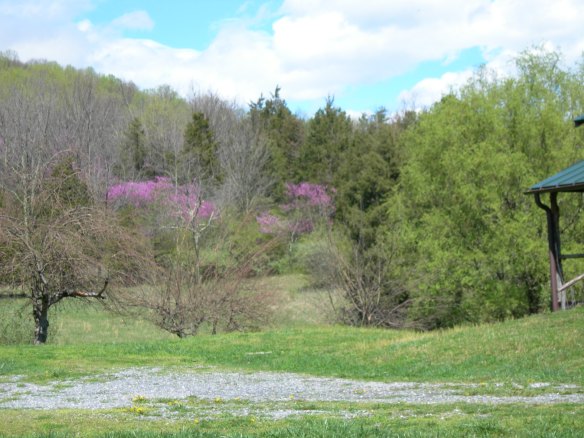After two days of pouring rain, South Buffalo Creek has swollen to double its normal size. In some places, the creek has overrun its banks, sending the swirling water into overflow channels carved out during previous spring storms. Once the fields became saturated, the water streamed down both sides of our lane. Among the creatures enjoying this deluge are the northern peepers – the rain recharged the wetlands in our front field where these tiny frogs are in full mating mode. It’s spring in the Blue Ridge!
Monthly Archives: March 2012
the color of spring
It’s just barely spring in the Blue Ridge, but nature can wait no longer, bursting forth in glorious color. Driving the back roads, all along the woods’ edge the pink blossoms of redbud and wild cherry trees are visible. The yellow and gold hues of buttercups, daffodils, and goldenrod dot the fields and meadows. Bees feast on the purple henbit that grows in the poorer soils along field edges and hillsides.
After this morning’s rain, though, the landscape is dominated by green. The grass is growing so fast you can almost hear it grow and the trees are hurrying to send out their new leaves to catch the rain and the sun’s rays. The yellowy-green willow tree next to our neighbor’s pond sits in contrast to the darker green of the surrounding grassy meadow and the pines at the base of the mountain in the background. On this particularly verdant morning, green is the color of spring.
Now every field is clothed with grass, and every tree with leaves; now the woods put forth their blossoms, and the year assumes its gay attire. ~Virgil
jeepers! peepers!
This week we began hearing the high-pitched calls of the male northern spring peepers in our front field. They are calling to attract a female. After mating, the female lays several hundred eggs, which are attached to vegetation in permanent or vernal (temporary) ponds. In about two weeks, the eggs hatch and tadpoles metamorphose approximately three months later. When the breeding season is over, the peepers retreat upland to damp, wooded areas.
The wetlands in our front field were created several years ago when our neighbor put in a pond, the overflow from which, created a perfect breeding place for the peepers. Every evening, as the sun goes down behind the mountains, the chorus erupts. When hundreds of peepers add their voices to the chorus, the din sounds like distant sleigh bells. It’s an amazing thing to hear.
It is not half so important to know as to feel. — Rachel Carson
love is in the air
The birds are in major mating mode. Today, two red-bellied woodpeckers called back and forth to each other, exchanging rolling, “churr, churr” calls. Communicating with each other at frequent intervals throughout the day strengthens the pair bond.
Woodpeckers start breeding earlier than most birds. In February, they can be heard “drumming” on resonant tree trunks to attract a mate and send the message to other birds that “this territory is taken!” Occasionally, they will drum on downspouts, gutters, and the sides of houses and can be difficult to discourage, only stopping once they have found a mate.
By now, this pair has drilled a new nest cavity or taken up residence in an unoccupied cavity, and the female is getting ready to lay her eggs. We love having these colorful, vocal birds around and hope they produce another generation of offspring for us to enjoy.
the phoebes are back!
 First visit of the season by an Eastern phoebe. Phoebes are grayish-brown with a white breast and throat. They look like several other bird species; however, there are two big clues that you’re looking at a phoebe: their constant tail pumping and their call, a wheezy “phoebe, phoebe.” Their call sounds a lot like a child squeezing a rubber “squeeky” toy. This phoebe is holding a dragonfly in his beak.
First visit of the season by an Eastern phoebe. Phoebes are grayish-brown with a white breast and throat. They look like several other bird species; however, there are two big clues that you’re looking at a phoebe: their constant tail pumping and their call, a wheezy “phoebe, phoebe.” Their call sounds a lot like a child squeezing a rubber “squeeky” toy. This phoebe is holding a dragonfly in his beak.
A pair nested in our porch rafters last spring and kept us company all summer, long after their young had fledged. They called to each other throughout the day and would occasionally follow us around the farm, flying from tree to tree, sallying forth at times to snatch an insect from the air. Mated pairs tend to nest in the same place in successive years, so this pair is probably the same pair that nested here last year. We welcome these friendly birds and their voracious appetite for insects!
There is something infinitely healing in the repeated refrains of nature — the assurance that dawn comes after night, and spring after winter. — Rachel Carson




